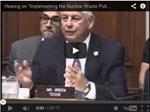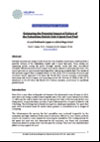Archive for the ‘News’ Category
Radiation Releases Continue from Nuclear Waste Isolation Project
Something Happened in February, Something is STILL Going On
July 6th, 2014
by William Boardman
Dissident Voice
Environmental radiation releases spiked again in mid-June around the surface site of the only U.S. underground nuclear weapons waste storage facility near Carlsbad, New Mexico. The facility, the Waste Isolation Pilot Project (WIPP), has been shut down since February 14, when its isolation technology failed, releasing unsafe levels of Plutonium, Americium, and other radio-nuclides into the environment around the site.
Radiation levels in the underground storage area, 2,150 feet below the surface vary from near-normal to potentially lethal. At the time of the February accident, more than 20 WIPP workers suffered low level radioactive contamination, even though none of them were underground. WIPP assumes, but cannot confirm, that underground conditions have not changed since May 31, when the last entry team went into the mine, as reported by WIPP field manager Jose Franco on June 5:
As I noted in my previous letter, we have identified the damaged drum believed to be a contributing source of the radiological release. On May 31, an entry team was able to safely and successfully collect six samples from a variety of locations in Panel 7 of Room 7, including from the breached drum and a nearby standard waste box. These sample results are consistent with the contamination previously identified.
In mid-March, WIPP suffered a surface radiation release almost twice the levels released in February. WIPP was designed to isolate highly radioactive nuclear weapons waste from the environment for 10,000 years. It went 15 years before its first leak of radioactivity into the above ground environment.
The latest elevated radiation levels were detected by monitors placed by the New Mexico Environment Department (NMED). The monitors measure radiation only after it has passed through the WIPP filtration system that is designed to minimize radiation from escaping from the storage area half a mile underground. Radiation levels in the storage area where the original leak occurred are possibly as lethal as Fukushima, hampering efforts to determine the source, cause, and scale of the February leak.
What happened underground remains a mystery and a danger
More than five months after the February accident, officials still have no certain understanding of what went wrong. It is generally thought that one 55 gallon drum of waste (perhaps more than one) overheated and burst, spilling radioactive waste in a part of the storage area known as Panel 7, Room 7. This room, designated a "High Contamination Area," measures 33 by 80 feet and presently has 24 rows of waste containers. The room holds 258 containers, tightly stacked and packed wall-to-wall, with no aisles to allow easy access. There is some clearance between the top of the stacks and the room’s ceiling.
The high contamination in Room 7 is a threat to human inspectors, limiting inspection of the room to date to mechanical means, primarily cameras on extension arms. As a result of these limitations, WIPP teams have inspected only ten of the 24 rows of waste containers in Room 7. Rows #1-14 have been out of reach of the available equipment.
WIPP has begun building a full scale replica of Room 7 above ground, to provide a realistic staging area in which to test methods of remote observation that might reach the 14 uninspected rows. According to WIPP:
Options include a device that uses carbon fiber rods to extend the camera, a gantry camera suspended on wires, or a boom system mounted on a trolley that would move across the waste face from wall to wall and out 90 feet to view all rows of waste.
WIPP has spent much of June improving the air filtration system to the mine, adding filters that reduce escaping radiation and improving underground air flow for the sake of entry teams. WIPP suspended underground entries on May 31, apparently to improve safety conditions. Reporting on June 18, field manager Jose Franco wrote:
Since the radiological event, we have safely entered the underground facility nearly a dozen times. Each time, we learn more and we use those discoveries to refine our tasks moving forward. Our entry teams have identified a breached container and we are using all of the resources at our disposal to find the cause.
No one is more eager than we are to determine what happened and return to normal operations.
Nuclear waste in Los Alamos puts National Lab at risk
"Normal operations" in the past included accepting thousands of waste-filled containers from the Los Alamos National Laboratory (LANL), which is under a June 30 legal deadline to clean up its above ground and shallow underground waste that has accumulated since the 1940s when Los Alamos scientists were building the first atomic bombs.
The contractor packaging LANL waste into containers made a change a while back, substituting organic kitty litter for the standard inorganic product. More than 500 containers with organic kitty litter have been prepared, 368 of them already stored underground at WIPP. One frequently cited theory (promoted by a WIPP booster) is that one or more of these containers underwent a chemical, heat-generating process because of the organic kitty litter and that reaction caused the container to burst.
The rest of these containers with organic matter are temporarily buried at a West Texas site or remain on the LANL property. They are under constant watch and reportedly none have failed to date.
Los Alamos has been under pressure to clean up its radioactive waste for years, if not decades. But it took the approach of wildfires to the LANL waste site for the laboratory to enter into a binding agreement with the state Environment Department to remove all the waste it has accumulated. As the June 30 deadline approached, LANL again asked the state for an extension of the deadline, saying there wasn’t enough money in its federal budget to comply with the court order.
In the past, the state had granted an extension more than 100 times. This time New Mexico said no. That will subject LANL to further sanctions, including fines.
Lawsuit over state-approved high-level waste containers
Almost two years ago, after the state approved new containers for use at WIPP without holding a public hearing on the application, the Southwest Research and Information Center (SRIC) sued to block the containers from coming into use. In the Center’s view, these new, shielded containers were less robust than containers already in use for highly radioactive waste. That issue should have been considered at a public hearing, SRIC argued at the time:
The Appellants and approximately 200 individuals requested that the request to modify the state’s WIPP permit be subject to a public hearing because of the dangers posed by RH [Remote Handled] waste, the technical complexity of handling RH waste at WIPP, and the substantial public interest in the request. NMED ignored those comments and approved the Department of Energy (DOE) request despite the fact that the state agency had in December 2011 and January 2012 rejected virtually the same request.
Remote Handled (RH) waste is so designated because radiation levels are too high to allow close personal contact, so the waste must be handled by remote-controlled machinery. About 10 per cent of WIPP waste is Remote Handled.
In December 2012, NMED had publicly announced a public hearing on the new container issue. The department rescinded the hearing notice four days later, without explaining the change.
The New Mexico Appeals Court heard closing arguments in the case in July 2013, but had not rendered a decision at the time of the February 2014 accident at WIPP.
On June 26, the court held a further hearing to consider whether the radiation release at WIPP was relevant to the use of the new, high-level waste containers. As reported by the New Mexican, this case has a number of anomalies:
The Environment Department said in an email that the shielded containers can be transported in fewer shipments, and the process is quicker and significantly reduces the dosage rates of radiation from the drums.
Moreover, although the department doesn’t know who manufactures the shielded containers, their safety has been vetted by the Nuclear Regulatory Commission and the Environmental Protection Agency….
Regulators and the nuclear watchdog group hope the judges will make a decision sooner rather than later. Even though WIPP is closed for now, a whole lot of highly radioactive waste has to be packaged into containers for temporary storage until shipments resume.
Investigations rampant, answers scarce
On June 16, four months after the radiation release from WIPP, the Department of Energy (DOE), announced its "decision to conduct an investigation into the facts and circumstances associated with potential programmatic deficiencies in the nuclear safety, radiation protection, emergency management, quality assurance, and worker safety and health programs revealed by the February 2014 fire and radiation release at the Waste Isolation Pilot Project."
Currently there are at least nine investigations into WIPP’s failure, including DOE, which operates the facility largely through private contractors. A few days later, a DOE attorney told the New Mexico Court of Appeals that "Nobody is contemplating a closure of WIPP", but that WIPP is unlikely to reopen until 2016 at the earliest.
In March, Don Hancok of SRIC published a piece listing questions that were then unanswered:
- What caused the leak?
- How much leaked into the underground salt mine?
- How much leaked into the environment?
- Where are those radioactive and toxic wastes now?
- To what amount of radiation were the workers exposed?
- What are the health effects for those workers?
- What decontamination is necessary in the underground mine?
- What decontamination is necessary on the WIPP site and surrounding area?
- If WIPP reopens, what changes in the operation, monitoring, and safety culture will be implemented?
On June 25, Hancock published another piece in the same online magazine, La Jicarita, pointing out that the questions of March all remained unanswered in June.
The piece carried this headline:
William M. Boardman has over 40 years experience in theatre, radio, TV, print journalism, and non-fiction, including 20 years in the Vermont judiciary. He has received honors from Writers Guild of America, Corporation for Public Broadcasting, Vermont Life magazine, and an Emmy Award nomination from the Academy of Television Arts and Sciences. This article was first published in Reader Supported News. Read other articles by William.
This document contains copyrighted material whose use has not been specifically authorized by the copyright owner. SEED Coalition is making this article available in our efforts to advance understanding of ecological sustainability, human rights, economic democracy and social justice issues. We believe that this constitutes a "fair use" of the copyrighted material as provided for in section 107 of the US Copyright Law. If you wish to use this copyrighted material for purposes of your own that go beyond "fair use", you must obtain permission from the copyright owner.
WCS’s Hiring of Legislative Aide Draws Ethics Concerns
May 13, 2014
by Jim Malewitz
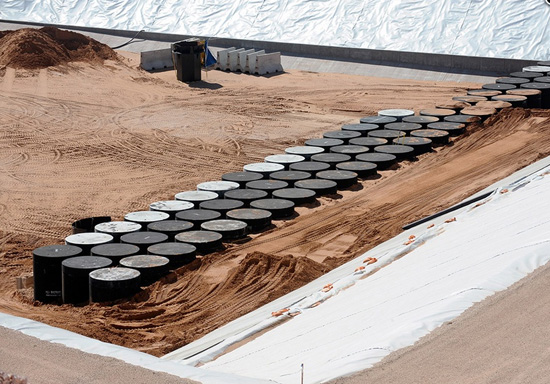
Modular concrete canisters containing nuclear waste are shown at the bottom of a storage pit near Andrews, Texas.
Photo by: David Bowser
Betsy Madru, the new vice president of government affairs at Waste Control Specialists, should have no trouble connecting with key lawmakers about policy that affects the billion-dollar company. She could either phone her old boss or simply look across the dinner table.
Madru, who began May 1 in a position that involves outreach to state officials, previously served as legislative director for state Sen. Kel Seliger, R-Amarillo. Seliger’s district includes Andrews County, home to the company’s vast storage and disposal site for hazardous and low-level nuclear waste, and Seliger has sponsored legislation that has allowed the company to expand the scope of waste it accepts. Madru worked on that policy. And Madru’s husband, Dan, a senior policy adviser for Texas House Speaker Joe Straus, has worked on a range of energy and natural resources issues, including radioactive waste disposal.
Straus this year instructed lawmakers to study the economic potential of storing highly radioactive nuclear waste in Texas that is stronger than WCS holds. If that long-shot idea became reality, it could yield billions more for WCS and the state.
Asked about Dan Madru’s involvement with environmental policy, a spokesman for Straus’ office released a statement late Monday saying that Madru’s role had changed.
"Speaker Straus and his entire staff take even the appearance of conflicts of interest very seriously, which is why Mr. Madru is no longer working on issues related to the environment,” Jason Embry, the spokesman said. “The Speaker and Mr. Madru are currently weighing other possible measures to ensure that no potential for conflicts, actual or perceived, exists."
Betsy Madru said there was nothing improper about her move. Critics, however, say it looks like a two-pronged conflict of interest. Though such jumps from state government to the private sector are legal and common, Madru’s additional connection to Straus made her case more problematic, said Fred Lewis, an ethics watchdog who is active in Democratic politics. Lewis spoke to The Texas Tribune before Straus’ office announced it had changed Dan Madru’s role. He had called Madru’s connections a "pretty obvious" conflict that "just makes people more cynical" about government.
"The spousal connection is worse," he said, because the Madrus would have simultaneous interests in the company and lawmakers who set its rules that affect the company.
Betsy Madru, who began working in Seliger’s office in 2010 after spending five years at the Texas Commission on Environmental Quality, said, "It’s always fair to raise questions, but do I think that there is an issue with impropriety? No, I don’t."
"We have to be aware of it, and it would be irresponsible not to be aware, so we have to take that very seriously," she said, adding that she and her husband would " uphold the utmost professionalism."
WCS, formerly owned by the late Dallas billionaire Harold Simmons, is one of few sites in the nation that is licensed to store low-level radioactive waste. It has been storing contaminated items from shuttered reactors and hospitals at its site in rural West Texas since 2012.
The company, along with state and federal regulators, has repeatedly called the site safe. But environmental groups have scrutinized the facility as it has expanded the scale of waste it accepts, raising concerns about the effects on groundwater and other natural resources.
The company’s critics also raised questions about whether the millions of dollars Simmons donated over the years to Republican state lawmakers, including Gov. Rick Perry, influenced state decisions on waste policy, but Simmons had said he believed that Perry had Texans’ best interests in mind.
Chuck McDonald, a WCS spokesman, said the company needed to add Madru’s position as its business rapidly expands. He said he understands any ethical concerns about the hiring. "But from our point of view," he said, "if we’re looking to add a public affairs position at our company, we want someone who has experience in government and, more important, experience in our issue."
McDonald said that anyone who has been involved with Texas waste policy over the years — including the company’s critics — should be pleased that WCS has added a familiar face and someone who had developed an expertise on such complex issues.
Seliger said he understands why ethics concerns would exist, but said he does not see any ethical issues with the move.
"She understands what the Legislature’s take in many instances are on waste issues, and that’s sometimes in conflict with what WCS would like to do,” he said. “She’s going to be a pretty good arbiter of those issues."
During Madru’s stint in Seliger’s office, the lawmaker sponsored successful legislation that enabled WCS to begin accepting low-level radioactive waste from many states and a bill that allowed states to send more concentrated, or "hotter," waste.
In October 2013, Seliger and Madru were among several lawmakers and staffers whom WCS flew to Andrews for a "fact-finding trip," according to a lobby activities report filed with the Texas Ethics Commission. Madru said the trip, which included a tour of the facility in which she learned how the disposal site functions, occurred far before she contemplated working with the company.
Tom "Smitty" Smith, director of the Texas office of Public Citizen, which opposes storing radioactive waste in Texas, said he found nothing comforting in the hire. "Frankly, I’m horrified for all those reasons — that she’s smart, persuasive and she knows where all the flaws in the regulations are."
This document contains copyrighted material whose use has not been specifically authorized by the copyright owner. SEED Coalition is making this article available in our efforts to advance understanding of ecological sustainability, human rights, economic democracy and social justice issues. We believe that this constitutes a "fair use" of the copyrighted material as provided for in section 107 of the US Copyright Law. If you wish to use this copyrighted material for purposes of your own that go beyond "fair use", you must obtain permission from the copyright owner.
Five Suspect LANL Waste Containers Sent to Waste Control Specialists Site in Texas
Jun 12 2014
NuclearStreet
Department of Energy investigators have narrowed their focus to the contents of six transuranic waste containers destined for the Waste Isolation Pilot Plant, five of which were diverted to a site in Texas after a leak at WIPP in February.
Quoting legislative testimony by the head of New Mexico’s Environment Department Tuesday, the Albuquerque Journal reported that five containers from Los Alamos National Laboratory are being stored by Waste Control Specialists, which has buried suspect LANL waste to keep it temperature-stable. The other LANL container inside the WIPP repository in New Mexico is believed to be the source of a Feb. 14 radiation leak after a chemical reaction cracked its lid.
A LANL spokesman speaking with the Santa Fe New Mexican acknowledged weaknesses in the lab’s procedures related to changes in the material used to stabilize the waste. Researchers initially focused on a change from clay-based to organic kitty litter. Legislative testimony suggested the absorbent material provided fuel for the heat event that cracked the container but did not initiate the chemical reaction, which scientists so far have not been able to replicate. The other trait the six drums share is particularly acidic waste material from evaporators used in weapons development. Recently publicized emails show that LANL granted permission last summer for EnergySolutions to add a neutralizer to that waste that also held the potential for reactivity.
This document contains copyrighted material whose use has not been specifically authorized by the copyright owner. SEED Coalition is making this article available in our efforts to advance understanding of ecological sustainability, human rights, economic democracy and social justice issues. We believe that this constitutes a "fair use" of the copyrighted material as provided for in section 107 of the US Copyright Law. If you wish to use this copyrighted material for purposes of your own that go beyond "fair use", you must obtain permission from the copyright owner.
Five Highly Acidic Radioactive Waste Containers Stored in Andrews, Spokesman Says Public is Not in Danger
Jun 11, 2014
By Alicia Neaves
NewsWest 9
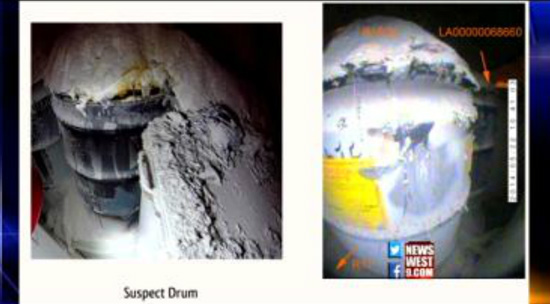
ANDREWS – NewsWest 9 has new details on five potentially explosive containers of nuclear waste. Turns out, they are all being stored in Andrews County. That waste came from the Los Alamos National Laboratory. They could be tied to a drum that caused a radiation leak at the underground nuclear storage site in Carlsbad. NewsWest 9 talked to Waste Control Specialists in Andrews County about the dangerous situation and how they’re handling it.
The New Mexico Environment Department confirms the Department of Energy is taking a closer look at six waste containers, all of which have very high acid levels along with nitrate salts mixed with organic kitty litter. Those six include the one which leaked radiation at the Waste Isolation Pilot Plant in Carlsbad. The other five are stored temporarily at Waste Control Specialists in Andrews.
On February 19, the New Mexico Environment Department confirmed radiation release into atmosphere. The source? A drum underground whose lid cracked.
Five more drums with the same highly acidic contents are under surveillance 24/7 at Waste Control Specialists in Andrews. If they get too hot, it could potentially be explosive.
"They’re constantly monitored, they’ve got temperature gauges on them, we know what the temperature is, we’ve got videos monitoring them in case there’s anything we need to know about we can act quickly," Chuck McDonald, Spokesman for Waste Control Specialists in Andrews, said.
To keep them cool, the 55-gallon drums are stored below ground inside a 25-foot concrete canister surrounded by rock material for insulation and sealed off with a heavy steel lid.
"Now we’re in the process of moving that into an area where we can surround it with dirt. The significance of that is it helps cool the containers. This time of year obviously heat is a factor so that will significantly reduce the temperature inside those containers," McDonald said.
These drums come from the Los Alamos National Laboratory in New Mexico. The rest of the bunch are stored in isolation, continuously monitored. Waste Control Specialists say all procedures are in place to monitor the waste and protect the community.
"We feel good at WCS that we’ve taken every precaution necessary to protect our employees and the health and safety of the area," McDonald said.
The U.S. Department of Energy says, "WIPP, the Los Alamos National Laboratory, and Waste Control Specialists (WCS) have compensatory measures in place to ensure the people and the environment are protected. Any waste containers of concern are segregated from other containers at the sites."
A popular theory is that because of a switch from inorganic to organic kitty litter at Los Alamos, that is what caused the overheating which popped the lid off the 55-gallon barrel in Carlsbad.
Scientists are still trying to mimic what caused the barrel lid to crack underground at the Waste Isolation Pilot Plant in Carlsbad. Again, the five drums are only temporarily stored in Andrews. They will stay until the WIPP facility is re-opened in about two weeks.
This document contains copyrighted material whose use has not been specifically authorized by the copyright owner. SEED Coalition is making this article available in our efforts to advance understanding of ecological sustainability, human rights, economic democracy and social justice issues. We believe that this constitutes a "fair use" of the copyrighted material as provided for in section 107 of the US Copyright Law. If you wish to use this copyrighted material for purposes of your own that go beyond "fair use", you must obtain permission from the copyright owner.
Waste Control Specialists in Andrews Looking to Expand in the Future, Lower Liability Claims
Jun 18, 2014
By: Alexa Williams
NewsWest 9
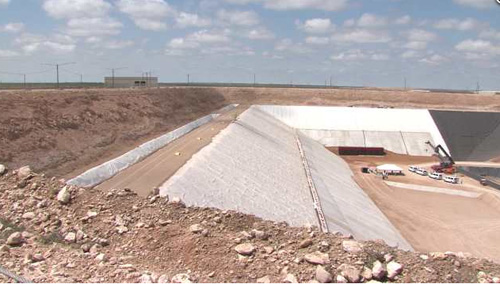
ANDREWS– The Waste Control Specialist site in Andrews is looking to expand. Right now, WCS in Andrews can legally hold up to 2.3 million cubic square feet in radioactive waste. But years down the road, the capacity could skyrocket to nine million cubic feet. That’s triple its current size.
“WCS has filed a license amendment with the Texas Commission on Environmental Quality regarding its compact disposal facility to be expanded if the need was there for additional capacity for disposal,” WCS Spokesman, Chuck McDonald, said.
WCS said the need probably won’t be for decades but they have to plan for the future.
“The reason for the license amendment was in the last legislative session there was concern that 30 to 40 years from now when the State of Texas needs be assured that it has capacity for decommissioned nuclear power pant, that the space will be available,” McDonald said.
Planning for expansion isn’t the only big change WCS is working on. The company said they’re trying to lower their liability claims from $136 million to around $85 million. All because the plant is smaller than expected.
“While it’s a significant operation out in Andrews County ultimately what was built was not what was anticipated. So the financial insurance requirement, we’re trying to amend the license. We’re trying to make it reflect the actual operations rather than the 2004 proposal,” McDonald said.
We’re told the amendment to expand will be final by the end of this year.
This document contains copyrighted material whose use has not been specifically authorized by the copyright owner. SEED Coalition is making this article available in our efforts to advance understanding of ecological sustainability, human rights, economic democracy and social justice issues. We believe that this constitutes a "fair use" of the copyrighted material as provided for in section 107 of the US Copyright Law. If you wish to use this copyrighted material for purposes of your own that go beyond "fair use", you must obtain permission from the copyright owner.

